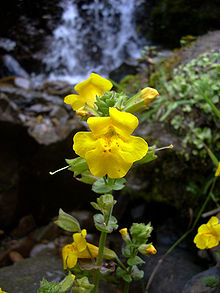- Mimulus guttatus
-
Mimulus guttatus 
Scientific classification Kingdom: Plantae (unranked): Angiosperms (unranked): Eudicots (unranked): Asterids Order: Lamiales Family: Scrophulariaceae Genus: Mimulus Species: M. guttatus Binomial name Mimulus guttatus
DC.Mimulus guttatus, the Common monkey-flower, is a yellow bee-pollinated annual or perennial herbaceous wildflower that grows along the banks of streams and seeps in western North America.[1]
Contents
Description
A highly variable plant, taking many forms, it is a species complex in that there is room to treat some of its forms as different species by some definitions. Mimulus guttatus is 10 to 80 cm tall with disproportionately large, 20 to 40 mm long, tubular flowers. The perennial form spreads with stolons or rhizomes. The stem may be erect or recumbent. In the latter form, roots may develop at leaf nodes. Sometimes dwarfed, it may be hairless or have some hairs. Leaves are opposite, round to oval, usually coarsely and irregularly toothed or lobed. The bright yellow flowers are born on a raceme, most often with five or more flowers. The calyx has five lobes that are much shorter than the flower. Each flower has bilateral symmetry and has two lips. The upper lip usually has two lobs; the lower, three. The lower lip may have one large to many small red to reddish brown spots. The opening to the flower is hairy.[2][3][4][5][6]
Distribution
Both annual and perennial forms occur throughout the species' range. It is found in a wide range of habitats including the splash zone of the Pacific Ocean, the geysers of Yellowstone National Park, alpine meadows, serpentine barrens, and even on the toxic tailings of copper mines. It is sometimes aquatic, its herbage floating in small bodies of water.
Mimulus guttatus has been a model organism for studies of evolution and ecology. There may be as many as 1000 scientific papers focused on this species. The genome is (as of 2008) being studied in depth.[1]
Cultivation
Mimulus guttatus is cultivated in the specialty horticulture trade and available as an ornamental plant for: traditional gardens; natural landscape, native plant, and habitat gardens.
References
- ^ "Mimulus guttatus DC.". PLANTS Profile. United States Department of Agriculture; Natural Resources Conservation Service. http://plants.usda.gov/java/profile?symbol=MIGU. Retrieved 2010-11-21.
- ^ Copyright © by the Regents of the University of California (1993). "UC/JEPS: Jepson Manual treatment for MIMULUS guttatus" (HTML). Treatment from the Jepson Manual. Regents of the University of California and University and Jepson Herbaria (UC/JEPS). http://ucjeps.berkeley.edu/cgi-bin/get_JM_treatment.pl?7177,7386,7412. Retrieved 2010-11-21.
- ^ "Mimulus guttatus DC.". GRIN Taxonomy for Plants. Germplasm Resources Information Network. http://www.ars-grin.gov/cgi-bin/npgs/html/taxon.pl?24442. Retrieved 2010-11-21.
- ^ "Mimulus guttatus". WTU Herbarium Image Collection. Burke Museum, University of Washington. http://biology.burke.washington.edu/herbarium/imagecollection.php?Genus=Mimulus&Species=guttatus. Retrieved 2010-11-21.
- ^ Pojar, Jim; Andy MacKinnon (2004). Plants Of The Pacific Northwest Coast: Washington, Oregon, British Columbia & Alaska. Lone Pine Publishing. p. 264. ISBN 978-1551055305.
- ^ Turner, Mark; Phyllis Gustafson (2006). Wildflowers of the Pacific Northwest. Timber Press. p. 244. ISBN 978-0881927450.
External links
 Media related to Mimulus guttatus at Wikimedia CommonsCategories:
Media related to Mimulus guttatus at Wikimedia CommonsCategories:- Phrymaceae
- Flora of the Western United States
- Flora of Western Canada
- Flora of the West Coast of the United States
- Flora of British Columbia
- Flora of the Sierra Nevada region (U.S.)
- Flora of California chaparral and woodlands
- Flora of the California desert regions
- Garden plants of North America
- Aquatic plants
- Garden plants
- Plants and pollinators
- Model organisms
- Lamiales stubs
Wikimedia Foundation. 2010.

